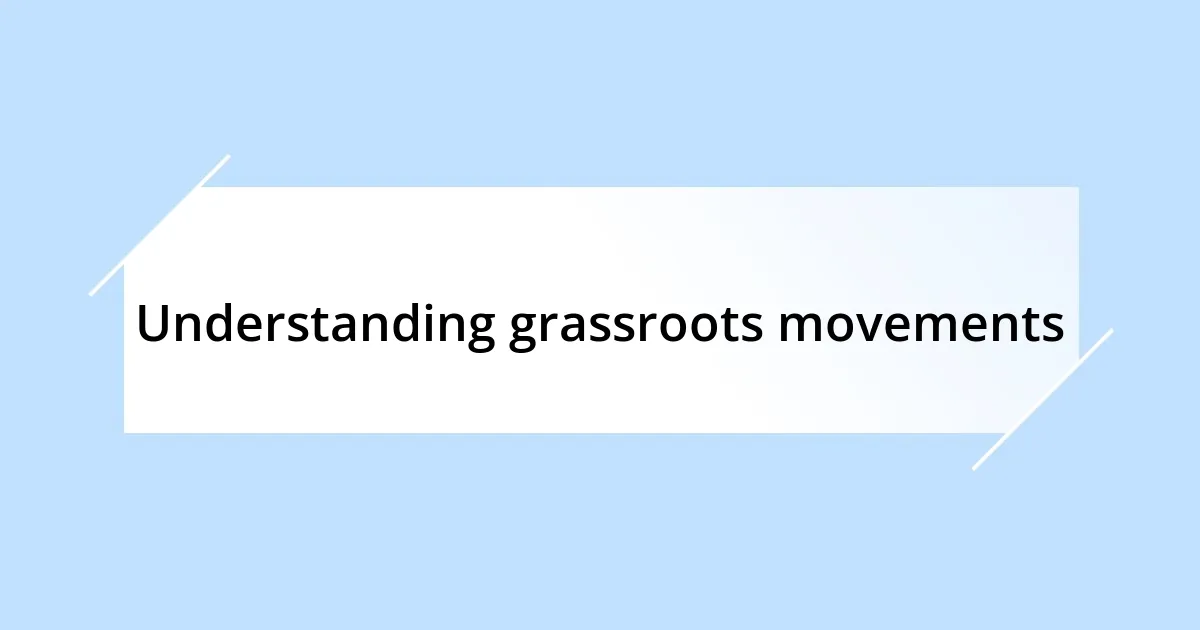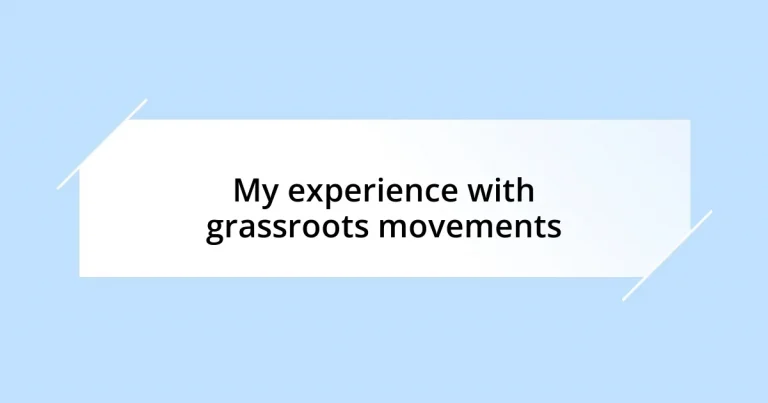Key takeaways:
- Grassroots movements empower communities by fostering collective action and inclusivity, leading to substantial social change.
- Effective organizing strategies include building strong community networks, ensuring clear communication, and leveraging social media for broader outreach.
- Measuring impact requires both qualitative and quantitative methods, focusing on community stories and long-term changes to gauge success.
- Building genuine relationships and maintaining adaptability are crucial for sustaining momentum in grassroots initiatives.

Understanding grassroots movements
Grassroots movements are powerful forces for change that arise from the collective efforts of individuals in a community. I remember attending a local town hall meeting where residents passionately discussed an issue affecting our neighborhood. It struck me how ordinary people, often overlooked, could come together to amplify their voices and effect real change—doesn’t that make you think about the impact of community action?
One of the most fascinating aspects of grassroots movements is their organic nature. These initiatives often start small, driven by a few passionate individuals who are determined to address a specific problem. Reflecting on my own experience helping organize a neighborhood clean-up, I felt the energy shift as more people joined in. It was a beautiful reminder of how collective actions can sow the seeds for broader social change—have you ever participated in something that made you feel that powerful connection?
Moreover, grassroots movements often bring forth diverse perspectives, highlighting the importance of inclusivity. In my experience, I’ve witnessed how the collaboration of various voices creates a richer dialogue and more effective solutions. It raises the question: how can we ensure every voice is heard in these movements? Embracing differing opinions and backgrounds can fortify the foundation of any grassroots initiative, driving it toward success.

Benefits of grassroots activism
Grassroots activism brings a host of benefits that resonate deeply within communities. One standout advantage is the sense of empowerment it fosters among individuals. When I joined a local campaign for better public transit, I was amazed at how people transformed from passive observers into active participants. This shift not only boosts individual confidence but also strengthens communal ties, creating a vibrant tapestry of shared purpose.
Here’s a quick rundown of some other key benefits of grassroots activism:
- Community Engagement: It encourages everyday citizens to get involved, fostering a sense of ownership and responsibility.
- Tailored Solutions: Local activists understand their community’s unique needs, leading to initiatives that are more relevant and effective.
- Increased Awareness: Grassroots movements can shine a spotlight on overlooked issues, educating the public and inspiring action.
- Organic Growth: These movements often evolve in response to community needs, allowing for flexible strategies that can adapt over time.
- Building Networks: I’ve found that participating in these movements not only connects you with like-minded individuals but also cultivates relationships that can lead to lasting change.
The empowerment that arises from grassroots activism ignites hope, reminding us that collective efforts can lead to substantial change. I distinctly recall the excitement at our local rallies, where each chant and cheer felt like a testament to the power of united voices. There’s an undeniable strength in numbers, and witnessing that firsthand is incredibly invigorating.

Key strategies for organizing
One key strategy for organizing a grassroots movement is building a strong community network. In my own experience, I once helped a group rally for better green spaces in our neighborhood. It wasn’t just about having a few passionate individuals; it was essential to connect with local families, schools, and businesses. That collaboration created a ripple effect, amplifying our message and gathering diverse support. Have you ever noticed how a simple conversation can snowball into something much larger?
Another important strategy centers on clear communication. When I was involved in coordinating a neighborhood safety initiative, we made it a point to keep all participants informed through regular updates. This transparency fostered trust and encouraged involvement from those who might have otherwise remained passive. I found that when we shared our wins, no matter how small, it motivated us all to keep pushing forward.
Additionally, leveraging social media can significantly enhance outreach and engagement. I learned this lesson the hard way after planning an event that only a handful of people attended. After that experience, I realized the power of telling our story online, posting photos, and sharing updates to draw in new supporters. The positive response we received showed me just how essential it is to meet people where they are—online.
| Strategy | Description |
|---|---|
| Building Community Networks | Connecting with local organizations and individuals boosts attendance and support. |
| Clear Communication | Regular updates and transparency build trust and motivation. |
| Leveraging Social Media | Using online platforms to share stories can enhance outreach and connection. |

Building community support
Building community support is all about making personal connections that resonate deeply with those around you. When I first joined an initiative focused on environmental issues, I remember sitting down with neighbors over coffee to discuss their hopes for a healthier community. Those intimate conversations opened doors—people began sharing their stories, and what struck me most was how quickly the room filled with shared frustrations and aspirations. Does it ever surprise you how much you can learn from a cup of coffee?
Engaging community members in meaningful dialogues lays the groundwork for solid support. I recall a community workshop we organized; it felt electrifying as people came together to brainstorm local solutions. I noticed that once individuals felt heard, they were more willing to contribute their time and resources. Have you ever felt that sense of ownership when your voice is valued? It sparks something transformative—almost like igniting a lightbulb moment where everyone realizes they can be a part of the change they want to see.
Furthermore, it’s essential to celebrate even the smallest victories together. I vividly remember throwing a small block party after we succeeded in getting funding for a local park. The joy on everyone’s faces—not just from the celebration, but from the realization that we achieved something as a community—was infectious. It’s those moments that solidify relationships and inspire people to engage further. When we collectively invest our energy into these shared experiences, we create a powerful sense of belonging that keeps the movement alive and thriving.

Utilizing social media effectively
In my experience, using social media isn’t just about broadcasting your message; it’s about creating a dialogue. I remember posting about a litter cleanup event in my neighborhood, but what surprised me was the number of comments and messages we received from people expressing their excitement and wanting to get involved. It made me realize how vital it is to listen to your audience online—engagement can transform followers into active participants. Have you ever had a conversation on social media that led to something meaningful in real life?
Visual content plays a crucial role as well. After attending a rally, I started sharing photos and videos on Instagram to capture the energy and passion we felt that day. The reaction was immediate; friends and strangers alike began sharing our posts, and our event gained traction. This experience taught me that compelling visuals can convey emotions more powerfully than words alone, drawing people in and inspiring them to join us in our mission. Isn’t it fascinating how a single snapshot can encapsulate an idea or feeling so effectively?
Additionally, timing your posts to align with current events can also amplify your voice. I found that when there’s a trending topic related to your movement, engaging with that conversation can bring new eyes to your cause. For instance, during World Environment Day, we shared our goals and invited people to participate in local efforts to combat climate change. The response was incredible! It highlighted for me the importance of being proactive and strategic; connecting your efforts with broader conversations creates a sense of urgency and relevance, invigorating community interest. Have you ever noticed how a timely message can rally support in unexpected ways?

Measuring impact of movements
Measuring the impact of grassroots movements often requires a mix of qualitative and quantitative methods. When I worked with a local organization, we decided to distribute surveys after our events. The results were eye-opening; not only did we learn the number of participants, but we also gathered personal stories that reflected the emotional connections formed through our efforts. It made me wonder: how often do we overlook the stories behind the numbers?
Another vital tool for measurement is the use of social media analytics. After promoting an initiative through Instagram and Facebook, I noticed how many shares and interactions our posts received. As we analyzed these metrics, it became clear that certain types of posts resonated more with our audience—like a video showcasing a community member’s transformation. I’ve often reflected on how these insights can guide future outreach strategies. Have you ever felt that excitement of a post reaching far beyond your original audience?
Moreover, it’s crucial to observe the long-term changes in the community. One time, we launched a campaign for better public transportation, and years later, I saw real improvements. The bus routes expanded, and people started using the services more. This evolution reinforced the idea that effective measurement goes beyond immediate results; it encapsulates the lasting impact we have on our communities. Isn’t it rewarding to witness the fruits of your labor grow over time?

Lessons learned from my experience
One significant lesson I learned is the power of building genuine relationships. During one of my grassroots initiatives, I reached out to local businesses for sponsorships. I was pleasantly surprised by the overwhelming support; many owners were genuinely interested in our mission. It became clear to me that when people feel personally connected to a cause, they’re much more likely to invest in it, whether that’s through time, resources, or spreading the word. Have you ever built a partnership that changed the trajectory of your project?
Another takeaway for me was the necessity of adaptability. During a community event, we faced inclement weather, which threatened to derail our plans. Instead of canceling, we quickly pivoted to an indoor space and incorporated activities suitable for children. I felt a mix of panic and excitement, realizing that flexibility can turn obstacles into opportunities. It struck me that being prepared for the unexpected is crucial in grassroots movements; adaptability can keep the momentum alive. Isn’t it fascinating how a minor adjustment can sometimes enhance the community’s experience?
Lastly, I learned that persistence is key. A campaign I led initially struggled to gain traction; many people simply didn’t see its relevance. It took multiple attempts, creative outreach strategies, and consistent messaging over months for our efforts to start resonating. But when we finally hosted an event that reflected our community’s identity, the turnout was beyond what I imagined. This journey taught me that resilience pays off and that lasting changes often require time and continuous effort. Have you ever faced a challenge that ultimately led to unexpected growth?














